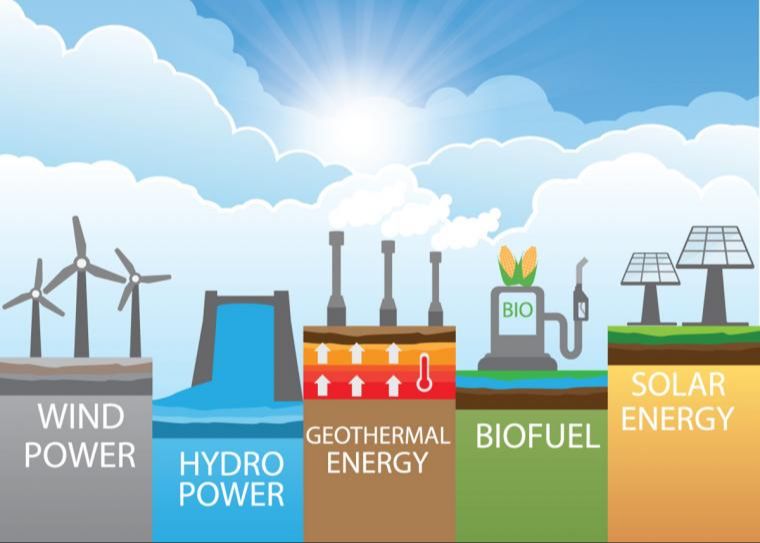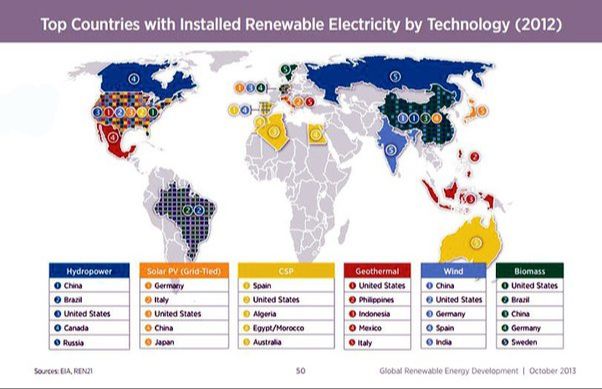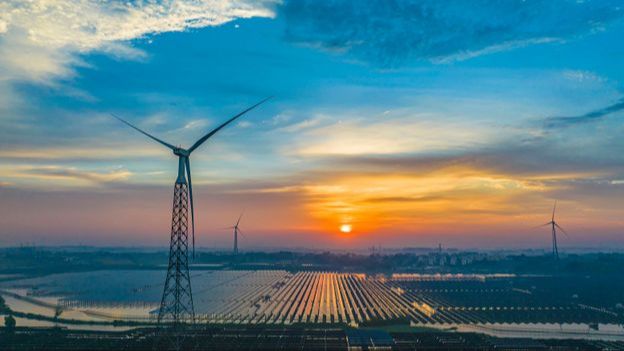Does Renewable Energy Have A Future?

In 2021, renewable energy sources generated 38% of global electricity, up from 34% just two years prior (https://earth.org/renewable-energy-facts/). Renewable energy comes from natural sources that are constantly replenished, like sunlight, wind, water, and geothermal heat. The main renewable energy sources used today are:
- Solar power – Converts sunlight into electricity using photovoltaic cells.
- Wind power – Converts wind energy into electricity using wind turbines.
- Hydropower – Converts the energy from flowing water into electricity using turbines.
- Geothermal – Harnesses heat from under the earth’s surface to generate electricity.
As renewable energy continues its rapid growth, it holds great potential to power the world in a sustainable way while mitigating climate change.
The Growth of Renewables
Over the past decade, there has been rapid growth in renewable energy capacity globally. According to the International Renewable Energy Agency (IRENA), renewable energy capacity grew at its fastest pace in over two decades in 2021, increasing over 8% to around 315 GW [1]. Total global renewable energy capacity is now over 3,000 GW, meeting over 30% of total electricity demand. The share of renewables in power capacity is expected to reach 50% in just the next few years .
The percentage of electricity from renewable sources has also increased substantially in many countries. In the European Union, renewables accounted for 22% of gross electricity consumption in 2020, up from 14% in 2010. In the United States, renewable electricity generation has doubled over the past decade to around 20% today [1]. Developing countries like India and Brazil have also made major investments in renewables in recent years.
A key driver of renewable energy growth has been the dramatic cost reductions, especially for solar and wind power. The levelized cost of electricity from utility-scale solar PV fell 85% between 2010-2020, while onshore wind costs fell 55% over the same period . In many regions, solar and wind are now the cheapest sources of new electricity generation.
Why Renewables Make Sense
Renewable energy provides numerous benefits over conventional fossil fuel-based energy. By tapping into renewable energy sources like solar, wind, geothermal, hydropower, and biomass, we can significantly reduce air pollution and greenhouse gas emissions linked to health problems and climate change. As the Environmental Protection Agency (EPA) notes, “Generating energy that produces no greenhouse gas emissions from fossil fuels and reduces some types of air pollution” is a core benefit of renewables (EPA). With renewables, we can also greatly enhance energy security and independence by relying more on domestic energy supplies and being less dependent on imported fossil fuels.
Beyond environmental and strategic benefits, renewable energy can provide cost competitiveness and savings versus conventional power generation. The Department of Energy (DOE) points out that renewables help create “Job creation throughout renewable energy industries, providing opportunities for both skilled and unskilled labor across the supply chain” (DOE). Investing more in renewables grows the job market in fields like manufacturing, installation, and maintenance. Renewables are also increasingly cost-competitive with fossil fuels and offer a free fuel source once installed. The EPA emphasizes that “Energy from the sun, wind, plants, and the Earth cost little to nothing to capture and convert” (EPA), highlighting the long-term savings versus paying continually for coal, oil, and natural gas.
Challenges Facing Renewables
While renewable energy has seen impressive growth, the industry still faces challenges that need to be overcome for renewables to reach their full potential. Some of the key challenges include:
Intermittency and storage issues – Many renewable energy sources like wind and solar are intermittent, meaning their electricity generation fluctuates based on weather conditions and time of day. This creates challenges for grid stability and reliability. Better energy storage solutions are needed to capture renewable power when it’s abundant and deploy it when it’s needed.
High upfront infrastructure costs – Building large-scale renewable energy projects requires significant upfront capital investment. This can limit adoption, especially in developing countries. More financing support and innovative business models are needed to reduce the high initial costs of renewable projects.
Transmission infrastructure needs – New transmission infrastructure like high-voltage power lines are important for transporting renewable electricity from source to demand centers. Building these can be costly and face public opposition and regulatory hurdles.
Fossil fuel incumbent advantages – Established fossil fuel industries still dominate energy markets. Renewables often compete against subsidized fossil fuels and powerful incumbent companies. Creating a level playing field is critical for renewable growth.
Key Technologies
There are several key renewable energy technologies that are driving growth in the sector. These include solar photovoltaics (PV), onshore and offshore wind, hydropower, and geothermal energy.
Solar PV involves converting sunlight directly into electricity using semiconducting materials. Solar panels consist of many solar cells that absorb sunlight and generate an electrical current. Solar PV systems can be installed at both small and utility-scale levels. The advantages of solar include that it is abundant, renewable, and produces no direct emissions. However, it can have high upfront costs and relies on sunshine, so energy storage is often needed 1.
Wind power harnesses the wind to generate electricity through wind turbines. Onshore wind involves wind farms located on land, while offshore wind is situated in bodies of water. Wind energy is clean and plentiful but intermittent. Advantages include low operating costs, while challenges include suitable siting and public opposition 1.
Hydropower utilizes the movement of water to generate electricity through dams and turbines. It provides stable, flexible baseload power with low operating costs, but depends on suitable geography and river flows. Large hydropower projects also alter local ecosystems 1.
Finally, geothermal power taps into the heat stored beneath the earth’s surface to produce energy. Geothermal plants use wells and pumps to extract hot water or steam to drive turbines. Advantages include providing constant output. However, geothermal is limited to areas with adequate subsurface heat and can contribute to small earthquakes 1.
Innovations That Will Shape the Future
Several key innovations in renewable energy technology are poised to accelerate adoption and tackle existing limitations over the coming years. Advances in battery storage will enable renewables to provide consistent power even when the sun isn’t shining or wind isn’t blowing. For example, lithium-ion batteries have drastically dropped in price recently, with costs projected to fall further as production scales up, allowing excess renewable energy to be stored for later use (source).
Offshore wind and floating turbines are unlocking vast new sources of wind energy, especially important considering wind remains one of the most cost-effective renewables. Floating turbine foundations now allow wind farms to be installed further out to sea in previously inaccessible waters (source). Hybrid renewable systems that combine multiple sources like solar, wind, and geothermal energy will increase grid resilience and stability.
Smart grids and distributed renewable energy solutions will also be critical, allowing real-time coordination of many small energy producers and consumers. Rather than a centralized grid, smart systems can dynamically optimize supply and demand (source). Overall, these innovations will enable renewables to keep growing as a share of the global energy mix.
Policy and Regulations
Government policies and regulations play a crucial role in accelerating the adoption of renewable energy around the world. Policy support mechanisms like renewable energy credits, portfolio standards, and national targets provide incentives and mandates to increase generation from renewable sources (Alhusainan, 2012). For example, the European Union has set targets for member states to source 32% of energy from renewables by 2030. China aims to source 20% of its energy from renewables by 2030. At the state level in the U.S., over half have adopted renewable portfolio standards requiring utilities to generate a percentage of their electricity from renewables (Renewable Energy, n.d.).
Regulatory environments are evolving to accommodate the growth of renewables. Grid operators are updating market rules to integrate more wind and solar. Permitting processes are being streamlined. Net metering policies compensate solar owners for excess generation fed back to the grid. As costs continue to fall and competitiveness increases, regulatory reform will be crucial to enabling the renewable transition.
Corporations and Renewables
Major corporations around the world are increasingly committing to 100% renewable energy. The RE100 initiative launched by The Climate Group brings together over 450 international companies pledged to using 100% renewable electricity across their global operations, with members like Apple, Google, Microsoft, Coca-Cola, and Goldman Sachs (1). According to RE100’s 2023 annual report, 181 TWh of renewable electricity was collectively procured in 2021, a 35% increase from 2020. The top 10 member companies alone accounted for 47% of this demand (2).
The business case for corporations to switch to renewable energy is compelling. Renewables can provide a hedge against fossil fuel price volatility and deliver cost savings over the long term. Sourcing clean energy also helps companies meet emissions reduction targets and satisfy growing demand from investors, shareholders, customers and employees for sustainable business practices (1). Major brands are recognizing renewable energy as an opportunity to improve reputation, competitiveness and climate resilience.
The growth of corporate renewable energy procurement is driving large-scale investments in wind and solar around the world. Companies are utilizing techniques like power purchase agreements and green tariffs to contract for clean power. Access to affordable renewables remains a challenge in some markets, but improving policy environments and maturing technologies continue to enable the corporate transition.
(1) https://www.there100.org/re100-introduction-renewable-energy
(2) https://www.there100.org/sites/re100/files/2023-01/CDP_RE100_Report_2023%20%282%29.pdf
Developing World Adoption
Renewable energy can help achieve many sustainable development goals in the developing world. Expanding access to clean, affordable energy enables poverty reduction, improved healthcare and education, economic growth, and gender equality (IRENA, 2016). According to IRENA’s roadmap, doubling the global renewable share by 2030 could increase GDP up to 1.1% and raise global welfare by 3.7% (IRENA, 2016).
Many developing countries have seen significant renewable energy growth recently. China, India, Brazil, South Africa, and others have made major investments and policy commitments (REN21, 2019). Solar and wind are now the cheapest options for new power plants across most developing countries (IRENA, 2016).
Renewables can provide affordable, distributed energy access for rural and remote areas that lack electricity grid connections. Small-scale solar, wind, biomass, and hydropower systems are economic today for rural electrification (REN21, 2019). Energy access enables better healthcare, education, food production, and economic activity for isolated communities.
Conclusion
In conclusion, renewable energy has seen tremendous growth over the past decade, driven by falling costs, technological advances, and favorable policies. Key renewable sources like solar, wind and geothermal are now cost-competitive with conventional power in many markets. Renewables have gone from a niche to a mainstream energy source.
While challenges remain, from integrating variable renewables to upgrading grids, the overall trends point to continued expansion of renewables in the global energy mix. Ongoing innovations in storage, smart grids, and new technologies will further support the integration of renewables. Corporations and developing nations are also embracing renewables at an accelerating pace.
The future is bright for renewables to supply an ever greater share of our energy needs. With the right policies, investments and vision, renewables can continue their remarkable growth trajectory and help create a clean energy future. The transition to renewables is both necessary and achievable – and ongoing innovations will further accelerate this transition.
What are your thoughts on the growth and future prospects of renewable energy? I welcome your perspectives on this important issue.





